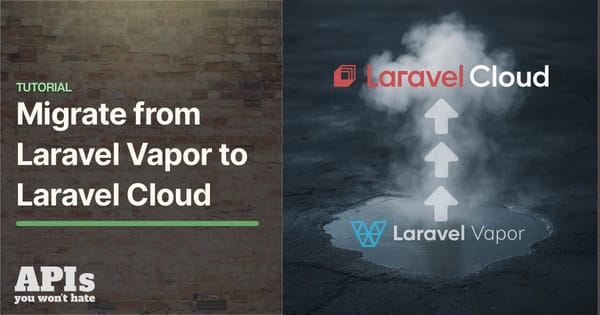Testing API Client Applications

One problem with building applications that talk to external dependencies like
APIs, is that the applications are talking to external dependencies. This opens
up a whole can of worms when it comes to testing the application.
You may well have heard developers saying: don’t let tests hit external
dependencies!
Some folks take that to various different extremes, and don’t even let
their tests talk to a database they control. That might make sense in
some situation, and not in others, but something pretty much everyone
agrees on is that a test suite hitting an actual API over the wire is
not ideal.
If the test suite is hitting a production API, you could end up sending
"funny" (offensive) test emails to a bunch of customers.
If a special testing API exists, then multiple developers hitting that
test server could cause state to bleed from one test to another, causing
race conditions, false positives, false negatives, or all sorts of
nonsense.
Trying to reset an external API back to a specific state for each test
is a fools errand. If you somehow manage it, your test suite now
requires the internet, meaning anyone of your team is gonna be screwed
next time they try working from a coffee shop, busy conference, plane,
etc.
Here are a bunch of solutions that not only help you cut the cord, but
help you get the application into specific states, improving the quality
of your tests.
Mocking Code Dependencies with Unit Tests
Hopefully your application is not littered with HTTP calls to this API
or their SDK directly, because that would be some tight coupling and
make it reeeeal hard to switch the API for another one if the company
yank it for some reason.
You probably have some thin layer wrapping their logic, giving you the
chance to swap things out without changing too much of your own code.
Maybe it looks a bit like this:
class Geocoder
def address(str)
google_sdk.geocode(str)
end
end
The application code has VenueService which is talking to Geocoder
and using the address method, which pops off to the Google Maps API to
do the thing.
To avoid the test suite hitting the external API, the most likely move
is to mock the Geocoder in the VenueService tests.
RSpec.describe VenueService do
describe '.update' do
it 'will geocode address to lat lon' do
allow(Geocoder).to receive(:address).with('123 Main Street') do
{
lat: 23.534,
lon: 45.432
}
}
subject.update(address: '123 Main Street')
expect(subject.lat).to eql(23.534)
expect(subject.lon).to eql(45.432)
end
end
end
Basically what we have here is a test (using RSpec but whatever it’s all
the same) which describes how the VenueService should work. The
update method is being tested, and the Geocoder is being set up
(monkey patched 🙈) to respond in a certain way.
For the VenueService unit tests this is fine, because the intent is to
make sure VenueService works with what we think Geocoder is going to
return. Unit tests for VenueService only focus on that class, so what
can we do to make sure Geocoder is working properly?
Well, unit testing that class is one option, but it’s not really doing
much other than talking to the Google Map SDK, and we really dont want
to mock that. Why? Because we don’t own it, and mocking things you dont
own is making guesses that might not be correct now, and might not be
correct later. The Google Maps SDK might change, and if all we have are
tests saying that the SDK works one way, but really it works another
way, then you are in false positive world: a broken application with a
lovely green test suite.
This will often be less of a problem for typed languages like Go,
TypeScript, PHP 7, etc., but changes can happen which those type systems
do not notice. For example, a foo property can still be a string, but
suddenly have different contents within that string.
Integration tests are very important to make sure things work
altogether.

Web Mocking in Integration Tests
Integration tests will be a bit more realistic as they hit more real
code, so the behaviour is closer to what is actually likely to happen in
production. This does mean integration tests can be slower than unit
tests.
Some developers avoid integration tests for this reason, but that is
reckless and daft premature optimization. Would you rather work on
speeding up a slow but reliable test suite, or have a broken production
with an untrustworthy test suite.
As integration tests hit more code, some folks think hitting the
external APIs is just going to happen, but not the case!
One approach to avoid hitting the wire, yet still having realistic interactions,
is to use something like WebMock
for Ruby, Nock for JavaScript, or the
baked in httptest in Go.
These tools are another type of mock, unlike the two other types of mocking
discussed so far. Instead of mocking a class in your programming language, they
mock a HTTP server. They are also very different from API specification based
mocking tools like Prism, which is a
whole other article.
Web mocking tools can be configured to respond in certain ways depending on what
URL, HTTP method, or body params are sent to it, depending on how complex things
want to get. Most of the time this is used for simple stuff.
Here’s an example taken from the CLI-tool
Spectral.
const invalidOas3SpecPath = resolve(__dirname, '__fixtures__/openapi-3.0-no-contact.yaml');
describe('when loading specification files from web', () => {
test.nock('http://foo.local', api =>
api.get('/openapi').replyWithFile(200, validOas3SpecPath, {
'Content-Type': 'application/yaml',
}),
)
.stdout()
.command(['lint', 'http://foo.local/openapi'])
.it('outputs no issues', ctx => {
expect(ctx.stdout).toContain('No errors or warnings found!');
});
});
This test is setting up a server on the arbitrary fake hostname
http://foo.local, with a GET path /openapi that returns a YAML file
with some specific content.
Then other tests can confirm what Spectral will do if it tries to load
an unsupported file type, the response contains a 404 status code, or
any other number of edge cases.
Web mocking is great for when you want to control the response, but once
again you should only mock things you own. Using this approach for the
Google Maps API example would only be confirming that the Geocoder works
with an assumption of what the Google Maps API is going to do. When
things change in the API there is no programmatic way to know about it.
Even if the change is noticed, updating these mock setups can be time
consuming. What we really want is something like Jest Snapshots, but for
HTTP request...
Record & Replay in Integration Tests
There is a tactic called "record and replay", and it is available in pretty much
every programming language in one form or another. Record & Replay has been
around for years, but I did not discover it until I started using Ruby. They
have a great tool called VCR ("Video Cassette
Recorder").
For younger developers a VCR is like Blueray but terrible quality and
the data is printed on a chunk of plastic you shove in a box under your
TV. It was mostly used for recording telly you weren’t able to watch at
the time, which is no longer a thing.
VCR explains the goals nicely, so I will use their words:
Record your test suite’s HTTP interactions and replay them during
future test runs for fast, deterministic, accurate tests.
The basic approach is to put your test suite in "record mode", which
will actually make real requests to the external services, but then it
records the response. All the headers, body content, status code, the
whole thing.
Then when the test suite is run not in record mode, it will reuse the
recorded responses instead of going over the wire, meaning it is quick,
always going to give the same result, and the entire response is being
used, so you know it is accurate.
require 'rubygems'
require 'test/unit'
require 'vcr'
VCR.configure do |config|
config.cassette_library_dir = "fixtures/vcr_cassettes"
config.hook_into :webmock
end
class VCRTest < Test::Unit::TestCase
def test_example_dot_com
VCR.use_cassette("synopsis") do
response = Net::HTTP.get_response(URI('http://www.iana.org/domains/reserved'))
assert_match /Example domains/, response.body
end
end
end
This is a rather verbose Ruby example for clarity. It includes the
config which would normally be tucked away in a helper, and it is
manually using a cassette block, but the idea is this: You can define
multiple cassettes, and switch them out to see the code working
differently.
How exactly it works under the hood might be a bit too much of how the
sausage is made, but it is very clever so I am going to nerd out a
little. In Ruby once again there is some monkey patching going on. It
knows to look out for common HTTP clients, and actually messes with
their definitions a little (only in the test suite). This sounds a bit
scary, but it means VCR can hijack the HTTP requests and use the
recorded versions instead.
Most of these record & replay tools can be configured to use the more
static web mocking tools mentioned previously. Ruby VCR for example can
use webmock, just think of VCR as a helper for creating these accurate
web mocks.
Another convenient thing about record & replay is the ability to have
expiring cassettes. You can configure these recordings to automatically
expire (vanish) after a certain amount of time, and then the test suite
goes back into record mode. Or you can have them throw warnings, and
hope some developers actually pay attention. This can be very annoying,
but you would not believe how often I have seen client application
developers use year old stubs with fields that did not exist anymore.
When recorded responses expire, clients need to go over the wire and
record new responses. This can be tricky if as the API might have
different data now. Some amount of effort can go into getting good data
on the API for recording, which might be a case of building a sort of
seed script. This annoyance is worth it in the long run, but certainly
takes some getting used to.
Expiring recordings go hand in hand with
deprecations
and evolution, especially Sunset and
Deprecated headers. If your applications are using reasonably up-to-date
recordings, then your test suite can start throwing deprecating warnings, and
loudly report about the code hitting is URLs marked for removal with Sunset.
The Ruby VCR was initially inspired by Chris Young’s
NetRecorder are the
inspiration for a lot of other record and replay tools, and they
maintain an impressive list of ports to other languages:
-
Betamax (Python)
-
VCR.py (Python)
-
Betamax (Go)
-
DVR (Go)
-
Go VCR (Go)
-
Betamax (Clojure)
-
vcr-clj (Clojure)
-
scotch (C#/.NET)
-
Betamax.NET
(C#/.NET) -
ExVCR (Elixir)
-
HAVCR (Haskell)
-
Mimic (PHP/Kohana)
-
PHP-VCR (PHP)
-
Polly.js (JavaScript/Node)
-
Nock-VCR
(JavaScript/Node) -
Sepia (JavaScript/Node)
-
VCR.js (JavaScript)
-
yakbak (JavaScript/Node)
-
NSURLConnectionVCR
(Objective-C) -
VCRURLConnection
(Objective-C) -
DVR (Swift)
-
VHS (Erlang)
-
Betamax (Java)
-
http_replayer
(Rust) -
OkReplay (Java/Android)
-
vcr (R)
If you are a JavaScript user then check out
Polly.js, comically written by
Netflix. It has some great config options.
polly.configure({
recordIfMissing: true,
recordIfExpired: false,
recordFailedRequests: false,
expiresIn: null,
timing: Timing.fixed(0),
matchRequestsBy: {
method: true,
headers: true,
body: true,
order: true,
}
})
The recordIfMissing is a good option, which means when folks add new
tests it will try to record the request when it is run the first time.
This can catch developers out if they are not expecting it, and can lead
to a rubbish response being recorded so they have to delete and try
again, but again it is worth getting used to.
Another one I like is recordFailedRequests: true. This is yet another
reminder that if the API is ignoring HTTP conventions like status codes,
this will not work. Ask the API developers to stop ignoring conventions
and build their APIs properly. Maybe send them a copy of Build APIs You
Won’t Hate. if they need convincing.
All this and more in Surviving Other Peoples
APIs, currently available
for pre-order, with roughly 80% of the book available for download.





